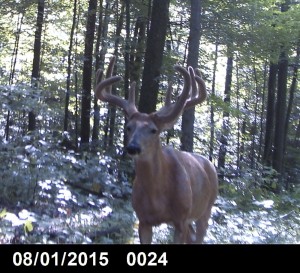 Exert advice on where to set your cams and find the biggest bucks on your hunting land
Exert advice on where to set your cams and find the biggest bucks on your hunting land
We are not going to bore you with what size tree to strap your camera to…how high off the ground to set it…or any other basic stuff you probably already know. What we are going to do is point you to 11 high-level locations, based on terrain and cover, where you are likely to capture images of the biggest bucks on your land. How solid are our sources for this advice? The experts quoted here have taken and analyzed hundreds of thousands of cam pictures of mature bucks over the years! Read on and find out where to get the buck photos. After that, the hanging of stands and closing the deal on a big deer are up to you.
Water Source
One August Iowa hunter Jay Gregory glassed a giant buck in one of his soybean fields. He snuck into a thick marsh less than a half-mile away and set up some trail cameras. Over the next couple of months he got five photos of the velvet buck–not a lot, but enough. The image time-stamped 9:00 a.m. on October 24 was gold–it showed the hard-antlered monster at the waterhole in broad daylight. Jay moved in with a tree stand and arrowed the beast a few days later—it gross-scored 198!
“After spotting a big buck in an ag field or food plot, sneak in and set a couple of cameras on well-used trails near the closest river, creek or marsh,” says Jay. “As summer deepens, mature deer spend a lot of time hanging out near water in low-lying areas. If you get lucky and set your cams in the right spot, you can find out where a giant is bedding.” Then plan your ambush on a trail between the bed and the feed.
Clearings
Another great spot for cams are small clearings in the timber 50 to 100 yards off a crop field or clover plot where deer are feeding on September or October evenings. “Some of my best camera locations are in these staging areas,” notes deer researcher Bryan Kinkel. “Mature bucks often hang up in these staging areas in late afternoon before moving out to a field at or after dark.” Find a staging area and set a cam on a fresh trail or rub line, or near an oak tree where acorns are falling. If you photograph a good buck, slip into the staging area, hang a stand and try to shoot him if the wind and access in the area let you do it.
Funnels
In the book Deer Cameras: The Science of Scouting Wisconsin bowhunter Todd Reabe reveals where he gets amazing daytime photos of monster bucks on his small, well-managed property. And day images are what you want, because that shows when and where you might arrow a whopper when he’s on his feet in shooting light. Todd stays away from field edges and instead aims his cameras into pockets and strips of security cover. “Small funnels and bottlenecks of thick cover between feeding and bedding areas are the best spots for my cams,” he says. Look for these secret cam hotspots on aerial photos and then go in and ground scout.
Fingers of Timber
Dr. Mickey Hellickson, one of the top whitetail biologists in America, has taken camera surveys for decades on properties from Iowa to Texas with the sole intent of finding terrains and covers where mature bucks routinely travel. “The spot where we’ve gotten the most mature buck photos is where 2 or more drainages or fingers of timber come together,” he says. Mick notes that these funnels may be large or small, but one constant is that “there is thick security cover nearby.” Hang cameras near these bottlenecks and you will find big deer. Then cross-reference the photos with aerial maps, consider fresh sign on the ground and hang tree stands for ambushes.
Evergreen Blocks
Hellickson’s surveys have revealed a second great place to set your cameras, especially later in the fall when the leaves blow down and the days get colder. “Our photos show mature bucks regularly use small blocks of timber with evergreen trees because the conifers provide increased security cover late in the year,” he says. Copses or wind rows of pines or cedars also break the wind and provide a warmer climate for deer on cold, north-wind days. Beginning in late November, set a couple of cameras in these habitats and be ready to move in with a stand when a bomber buck shows up.
Scrapes
Another of the world’s top deer biologists, Dr. Grant Woods, has analyzed hundreds of thousands of cam photos taken in all imaginable types of habitat from September through January. He says the best place to get buck shots bar none is at scrapes during the rut. Look for big, active scrapes deep in the timber and “monitor them throughout the rut, not just for two weeks during the peak,” he says. He explains that different bucks of all age classes show up at different scrapes at different times of the season—some come early in the pre-rut, some at peak, others don’t show until the post-rut phase. “Monitor the best scrapes for four to six weeks and you’ll see almost every buck big and small in the area,” says Woods. “You’ll get images of the local bucks on your land, and many of the transient bucks that work through too.”
Tree Stands
My friend Mark Drury straps a few cameras on the same trees (or on nearby trees) where he has fixed-position stands or shooting houses. He activates the units when he’s not hunting the stand. If a shooter shows up, he analyzes the time stamp on the pictures with regards to weather, wind direction, etc. He analyzes the directions the deer are coming from or traveling too. “It’s a simple thing that helps me nail down the best time to go back and hunt a particular stand,” says Drury.
Levee
Got a pond dam or lake levee in your hunt zone? Or maybe even an exposed, linear beaver dam? “It can be a magical bridge for deer from one block of timber to the next, or from woods to a field where they are feeding,” says Drury. “We set cameras on dams and run them all season. While a big buck might not travel on a dam say in October, might run it in the rut or in December or January when he’s hitting late-season corn or beans.” Pond dams with tall grass and weeds that can hide a buck as he sneaks around the best surveillance spots for cams.
Fence Jumps
Mark Drury’s older brother, Terry, loves to hang cameras near “fence jumps,” which can be found in various configurations. “It might be a low, drooping spot in a wire fence, a hole in a ditch below a fence, an open gap gate, or a spot where a tree has fallen across a fence and knocked it down,” he says. “Any point where deer funnel to and cross a fence every day.” Second only to scrapes in the rut, fence crossings are where Terry captures some of his best buck images every season. “Whether you have 2, 6 or 20 fences crisscrossing your property, bucks are going to cross them in funnel spots all season long,” he says. “If you watch those spots enough with your cameras you’re going to find some big deer.”
Bedding Cover
Experienced bowhunter Ron Bice hides some cameras in cover where he thinks or knows a good buck is bedding. “In dense cover deep in the timber, deer get up and move around a lot in daylight hours to browse or just stretch,” he says. “You never know what kind of buck you’ll catch in there.” It’s risky business because you have to sneak in there at least twice—once to set a camera and again to check the memory card–but it can pay off. “Get a picture of a big deer in his bedroom, and you’ve got a huge advantage,” notes Bice. “You get an idea where that buck is moving out of cover at dusk, and where he’s heading back at first light the next morning.” Then hang a tree stand along a nearby trail or funnel for a high-odds ambush.
Food Plots
It was brutally cold and snowy in northern Iowa one January, and Tim Young decided to bowhunt till the bitter end. He went against most of the advice you have read here so far. Instead of setting his cams back in the timber near thick cover, he placed them smack on the edges (and in some cases staked out in the middle) of small food plots across his hunting area. “When it’s cold and snowy in the late season like it was last year, the deer have to eat or they will die,” says Tim. He looked over the hundreds of pictures he was getting until he spotted a monster typical coming regularly to one plot. Game on. Tim hunted hard in the sub-zero temps for days until he finally got a 30-yard shot at the brute—he missed! Less than 6 hours later his cam showed the buck back eating in the same plot! Tim hung tough and on the second to last day of the season he killed the 180-inch giant. Your final lesson: “When it’s really cold and snowy in late winter, move your cameras out of the woods and tight as you can to the last food sources, you’ll find the bucks for sure,” says Tim.

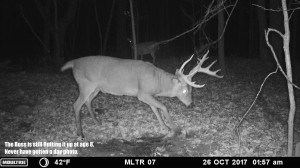
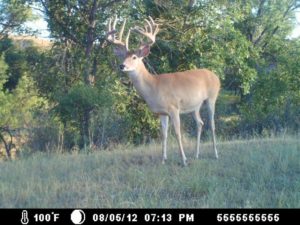
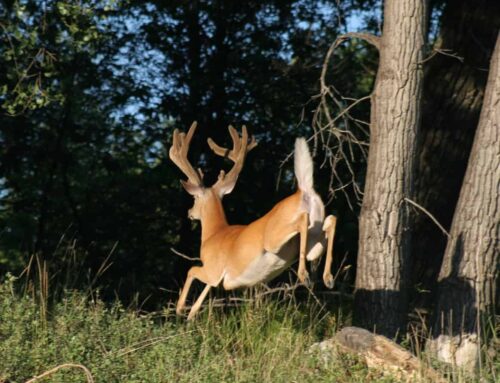
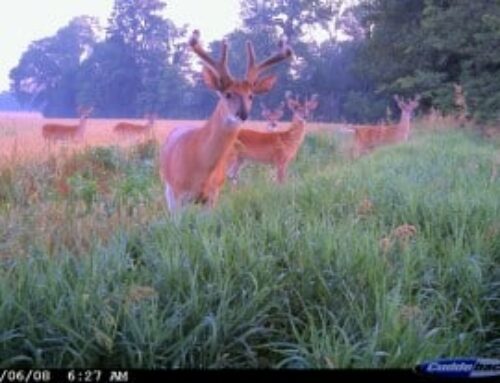



It’s very straightforward to find out any topic on web as compared to books, as I
found this article at this site.